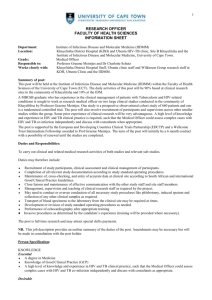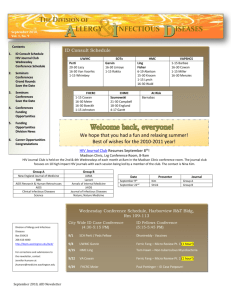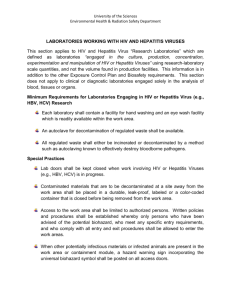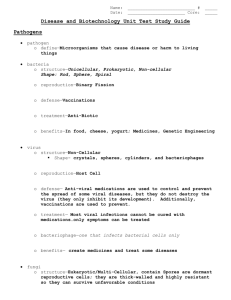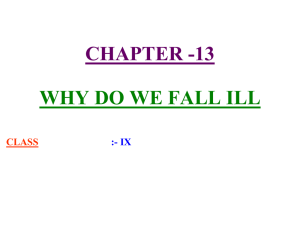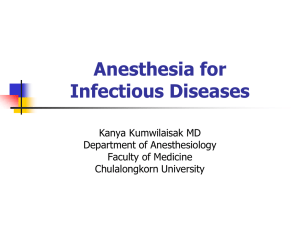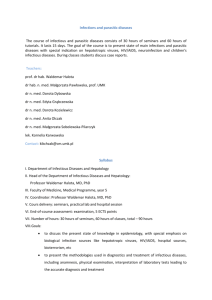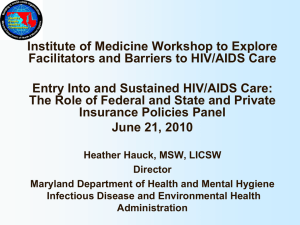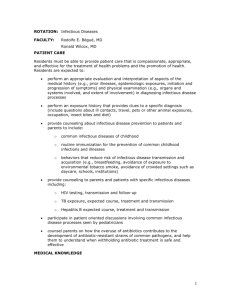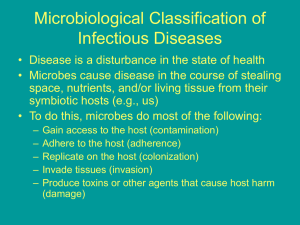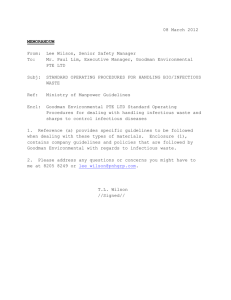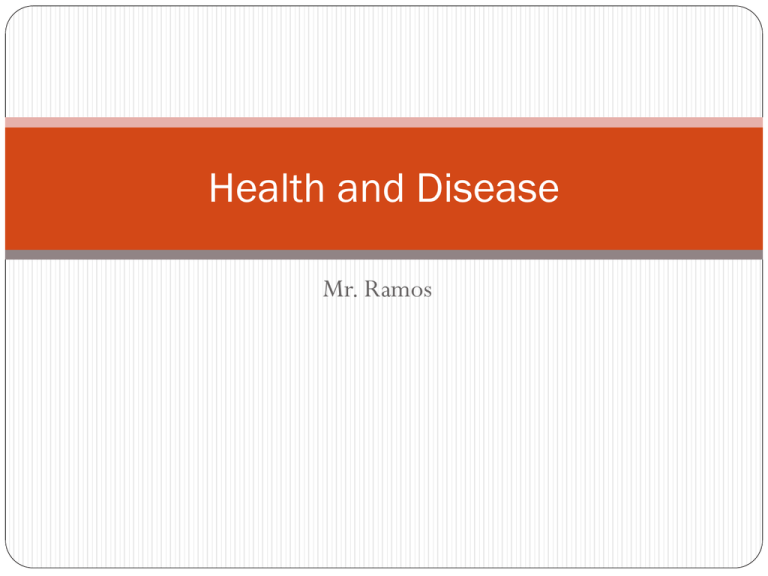
Health and Disease
Mr. Ramos
Introduction to Health & Diseases
Health is the state of one’s body.
Good health and bad health
Disease is anything that can lead to bad health.
Diseases in humans are caused by viruses, bacteria,
fungi, plants, protists, human genetics, & chemicals.
Public Health
Public health is the science that deals with protecting and
improving the health of people in a community.
How to help
Teaching people about disease & prevention
Providing clean water
Vaccination
Food & Drug safety
Promoting healthy habits
Blood Screening
Infectious Diseases
Infectious diseases can spread from one organism to another.
The organisms that cause infectious diseases are called
pathogens.
A parasite is any organism that lives on or in an organism and
harms it.
Some pathogens can release toxins to harm. Toxins are
poisons.
Infectious Diseases: Viruses
Viruses are tiny nonliving pathogens.
They can have DNA or RNA
Contain a protein coat
They are intracellular parasites
Their life cycle can be lytic or lysogenic
Examples: HIV, Flu, Ebola, Herpes, Rabies, Dengue
Virus Life Cycle: Lytic & Lysogenic
Infectious Diseases: Influenza
Flu is short for influenza.
The flu is caused by an RNA type virus.
Spread: sneezing, coughing, saliva.
Symptoms: fever, headaches, sore throat, coughing, severe
body aches, and more.
Treatment: plenty of rest, drinking water & electrolyte
beverages, pain and fever medication, antiviral medication.
Antibiotics are not needed.
The flu
constantly
mutates, so
you need a
flu shot each
year
Infectious Diseases: HIV
HIV stands for Human Immunodeficiency Virus
HIV destroys the human immune system and leads to Acquired Immune Deficiency
Syndrome (AIDS).
HIV is an RNA virus.
Spread: sex, blood, semen, breast milk, sharing needles.
Target: White Blood Cells (Helper T Cells)
Symptoms: fever, swollen lymph nodes, headaches, diarrhea, rash, cough, and many
more. Some people are asymptomatic.
Treatment: Cocktail of Antiretroviral drugs (no cure for HIV).
Infectious Diseases: HIV
The best and cheapest way to know if someone has HIV is to
check their blood for HIV antibodies.
ELISA is a blood test used to determine HIV antibodies.
Infectious Diseases: Parasites
Disease
Parasite
Spread By
Sleeping Sickness
Trypanosoma brucei
Bite of an infected tsetse fly
Amoebic dysentery
Entamoeba histolytica
Water or food contaminated by
body wastes or untreated
sewage
Malaria
Plasmodium vivax
Bite of an infected Anopheles
mosquito
Roundworm
Ascaris lumbricoides
Roundworm eggs that are
consumed in contaminated food
Pinworm
Enterobius vermicularis
Pinworm eggs that are
consumed in contaminated food
Infectious Diseases:
Chlamydia & Gonorrhea
Chlamydia and Gonorrhea are caused by bacteria.
Chlamydia is caused by the bacterium
Chlamydia trachomatis.
Gonorrhea is caused by the bacterium
Neisseria gonorrhoeae.
Spread: they are sexually transmitted infections
Treatment: Antibiotics (people can be cured)
Bacterial Gene Transfer: Conjugation
Bacteria can exchange information through a process called
conjugation.
Conjugation is a way to transfer information sexually
(remember that bacteria reproduce asexually).
“Male” bacteria have are F+. They have a plasmid and a sex
pilus.
“Female” bacteria are F-. They don’t have a plasmid or sex
pilus.
Preventing Infectious Diseases
Three important ways to prevent infectious diseases:
Stay away from sick people
Get vaccinated
Practice good hygiene
A vaccine is a weak or deactivated organism that is placed in
the body to trigger an immune response.
Noninfectious Diseases
Noninfectious diseases are not spread from one organism to
another.
Some noninfectious diseases are genetic, so they can be
passed down from parent to offspring.
Examples: Cystic fibrosis, Huntington’s disease, Sickle-cell
anemia, Hemophilia, Diabetes, Cancer.
Noninfectious Diseases
Environment factors & one’s behavior can increase the
likelihood for developing these disease.
Drinking too much alcohol can cause liver cancer.
Eating too much sugar can cause diabetes.
Chemicals & polluted air, such as asbestos may cause
lung problems.

